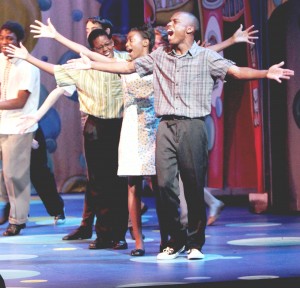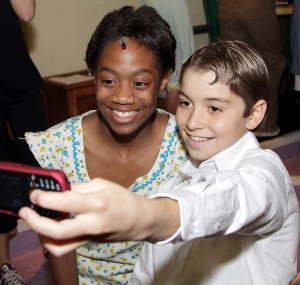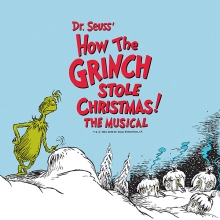HAIRSPRAY and HAIRSPRAY JR. Start a Summer Tradition in Des Moines
HAIRSPRAY and HAIRSPRAY JR. Start a Summer Tradition in Des Moines
By EllaRose Chary on July 2, 2012
 Last summer, Des Moines Community Playhouse, a community theater in Des Moines, Iowa, did something they had never done before – a main stage production of a musical running in repertory with a full-blown kids’ musical. The shows? HAIRSPRAY and a pilot production of HAIRSPRAY, JR. (score by Marc Shaiman and Scott Wittman (SMASH), book by Thomas Meehan and Mark O’Donnell). Director of Education and Youth Programming at the Playhouse, Kathy Pingel, said “this had every potential to be the biggest disaster on the face of the Earth,” because “the first time you do something, you don’t have that tradition of knowing what works and what doesn’t,” but instead of being a disaster it was one of the most successful programming decisions the theater has ever made, and one they plan to repeat many times in the future.
Last summer, Des Moines Community Playhouse, a community theater in Des Moines, Iowa, did something they had never done before – a main stage production of a musical running in repertory with a full-blown kids’ musical. The shows? HAIRSPRAY and a pilot production of HAIRSPRAY, JR. (score by Marc Shaiman and Scott Wittman (SMASH), book by Thomas Meehan and Mark O’Donnell). Director of Education and Youth Programming at the Playhouse, Kathy Pingel, said “this had every potential to be the biggest disaster on the face of the Earth,” because “the first time you do something, you don’t have that tradition of knowing what works and what doesn’t,” but instead of being a disaster it was one of the most successful programming decisions the theater has ever made, and one they plan to repeat many times in the future.Ms. Pingel highly recommends the experience to other groups and she recently shared some of the keys to Des Moines Community Playhouse’s success story with MTI Marquee.
A huge component of making this project work was the mentorship program that took place between the mainstage and the Jr. productions. By sharing creative and physical resources, the two shows were able to enhance each other and the kids benefitted from working with members of the adult company in a variety of ways. For example, the assistant director for HAIRSPRAY, a college student, was the director of HAIRSPRAY, JR. Assisting on the mainstage show allowed him to learn the ins and outs of the piece (and the set), and he brought that knowledge to the Jr. production. Additionally, some of the high school students had ensemble roles in HAIRSPRAY and then played leading parts in HAIRSPRAY, JR. Having already gone through the rehearsal process for the mainstage show meant they already knew the choreography, so they could help teach it to their fellow actors in the Jr. production. HAIRSPRAY’s costume designer helped guide the students as they made their own costumes for the Jr. show, teaching them about budgeting and shopping, as well as letting them use her leftovers. Whether the mainstage cast was actually working with the kids to help them improve their performances, or just coming by to appreciate what the kids were doing, the crossover between the two productions created a sense of community that was invaluable for both shows.
One concern Ms. Pingel had going into the production was diversity. A major plot point in HAIRSPRAY (JR. and full-length) is the integration of a Baltimore television program, and as Ms. Pingel put it:
“[In] Iowa…we struggle with what to do to make our population more diverse. Theater tends to be, in this area of the country, kind of a white bread operation and I was not going to be the first production of HAIRPSRAY, JR. in the Midwest and look all white, I just wasn't going to do that.”
With that in mind, the Playhouse set out to find ways to broaden the population that was involved with the show. This production turned out to be the “opportunity and the impetus” to diversify the theater community. In order to help achieve the goal of bringing in new people, the theater set up a system called “Education Ambassadors,” where Ms. Pingel reached out to school secretaries and religious leaders in different communities, offering scholarships to students who participated in the production – as long as those students committed to coming to rehearsals and performances. The Ambassadors came with students and parents to the theater, vouching for the program and providing support. The model ended up being so successful that a colleague in a nearby town adopted the program, with equally rewarding results.
The Playhouse credits the success of last summer’s productions of HAIRSPRAY and HAIRSPRAY, JR. to a number of factors, including giving the kids enough time to work on HAIRSPRAY, JR. and treating it like a full show despite the abridged nature of the piece. Ms. Pingel also notes the fact that the set could be used for both shows as a way that the theater was able to get more use out of its resources – she cautions, however, that they learned an important lesson. They built the set to last for four weeks of performance, as they normally would, without factoring in that the set would also be used for three additional weeks of rehearsal. That’s one thing she wishes she’d known going in, and something they're adjusting for this summer. Otherwise, she can’t think of a single reason not recommend this kind of repertory summer season to other theaters.
Excitement for the mainstage show bolstered interest in the Jr. production, and likewise participation in the Jr. production often led to a discovery of the mainstage show. Rather than limiting audience appeal by running similar versions of the same show simultaneously, the two productions enriched each other. With this in mind, the Des Moines Community Playhouse is planning a reprise in summer 2012, though with a slightly different model. The mainstage show will be RENT (by Jonathan Larson), and the kids will do FAME, JR. (Conceived and Developed by David De Silva, Book by José Fernandez, Lyrics by Jacques Levy, Music by Steve Margoshes) becuase they don't think their middle schoolers are quite ready for the School Edition of RENT. That said, they already are planning on sharing resources again between the shows, and are looking to a 2013 production of LES MISERABLES and LES MISERABLES, (School Edition). The best news: based on last summer’s success, the performance academy for this summer’s production filled up in April. Ms. Pingel’s final comments were:
“This was a big project, but the rewards were far greater than we had anticipated and positive all the way around. We’re proud to be a part of what MTI stands for and it was just all of it what you want to have happen with the Jr. product. It gives the kids an opportunity to be on that mainstage, but it doesn't exploit them.”
 Click here to learn more about the MTI Broadway Jr. Collection, which features a wide array of shows ranging from THE PIRATES OF PENZANCE, JR. to GUYS AND DOLLS, JR. If you're looking for more shows to do with kids, you can check out MTI School Editions here.
Click here to learn more about the MTI Broadway Jr. Collection, which features a wide array of shows ranging from THE PIRATES OF PENZANCE, JR. to GUYS AND DOLLS, JR. If you're looking for more shows to do with kids, you can check out MTI School Editions here.To see more pictures and video from the Des Moines Community Playhouses' production, visit MTI Showspace.
























